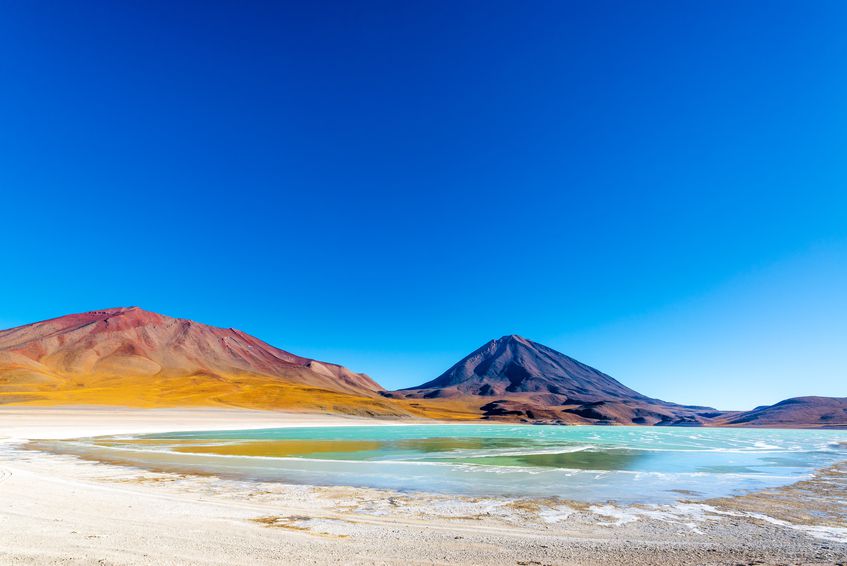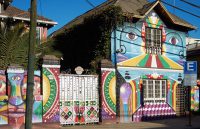You’d be hard pressed to find a country as captivatingly diverse as Chile. 2,670-miles (4,300 km) in length, it accommodates a tantalizing range of topographies, incomparably varied ecosystems and seven distinct climatic subtypes. As a result, an impressive array of natural landmarks are sprinkled throughout its territory, many of which have contributed towards Chile’s position as the most adventurous travel destination in South America. Read on as we guide you through the dramatic Chile landforms and topographic delights that you should visit.
Unique Chile Landforms: Deserts
The Atacama Desert
In the extreme north of Chile, and stretching over an area 41,000 square miles (105,000 km²) in size, discover the dusty, otherworldly plains of the Atacama Desert.
A patchwork of salares (salt flats), volcanoes, hot springs and miles and miles of sand, the Atacama Desert takes the prize for the most unusual yet spellbinding of all the Chile landforms.
Unsurprisingly, it has successfully positioned itself as one of the top tourist attractions in the entire country and a short trip to San Pedro de Atacama, the main town in the region, shouldn’t be left off your travel itinerary.
 How to visit: Flights from Santiago to the northern city of Calama (seven daily) and a one-and-a-half-hour bus journey will bring you to San Pedro de Atacama, from where you can organize tours to visit the region’s highlights.
How to visit: Flights from Santiago to the northern city of Calama (seven daily) and a one-and-a-half-hour bus journey will bring you to San Pedro de Atacama, from where you can organize tours to visit the region’s highlights.
When to visit: Temperatures – and tourist numbers – soar during the summer, so plan to arrive in November or March if you wish to avoid the heat and the crowds.
Child Landforms: Volcanoes
Osorno Volcano
Dubbed “the Fuji-yama of South America” thanks to its near perfect symmetry, it’s an impressive backdrop to an already spectacular scenery of expansive lakes and Valdivian Rainforest in the Chilean lake district. Sitting across Lake Llanquihue from the small town of Puerto Varas, it is easily accessible.
One of the most active volcanoes in Chile, it’s not actually seen an eruption since the mid-19th-century, making it an excellent choice if you’re looking to hike up one of the Chile landforms. You can climb Osorno Volcano from any of three starting points: Puerto Kloker, Ensenada and Petrohué. The climb takes approximately six hours and should be attempted with a local guide.
How to visit: Flights from Santiago to Puerto Montt (eight daily) and a 40-minute bus journey will bring you to Puerto Varas from where excursions to the volcano can be organised.
When to visit: During the summer months, conditions are best for hiking and climbing the volcano and surrounding landscapes, while in winter a small ski center is open to the public.
Chile Landforms: Fjords
Chilean Fjords
Skirting the southern coastline and southernmost tip of the country, the fjords are the least visited of all these incredible Chile landforms. Although a wonderland of groaning glaciers, bobbing icebergs and a wealth of extraordinary flora and fauna, their remoteness make them impossible to visit unless travelling by ship.
Yet it this inaccessibility that has allowed the various Magellanic penguin colonies and singular ecosystems of its national parks to remain preserved and unaffected by human contact, particularly give that humans have not inhabited these precious areas for centuries.
 How to visit: Cruise ships are the only way of exploring the most remote parts of the fjords, particularly at the southernmost tip of Chile. For those who do, expect a dream-like experience of sailing through magical fjords with only the sounds of the rippling waves in the wake of the ship to break the silence. Find out more about visiting the fjords with an Australis cruise.
How to visit: Cruise ships are the only way of exploring the most remote parts of the fjords, particularly at the southernmost tip of Chile. For those who do, expect a dream-like experience of sailing through magical fjords with only the sounds of the rippling waves in the wake of the ship to break the silence. Find out more about visiting the fjords with an Australis cruise.
When to visit: Travel through the fjords can become difficult during winter, so cruise ships only operate during the austral summer.
No comments yet
There are no comments on this post yet.





Leave a comment